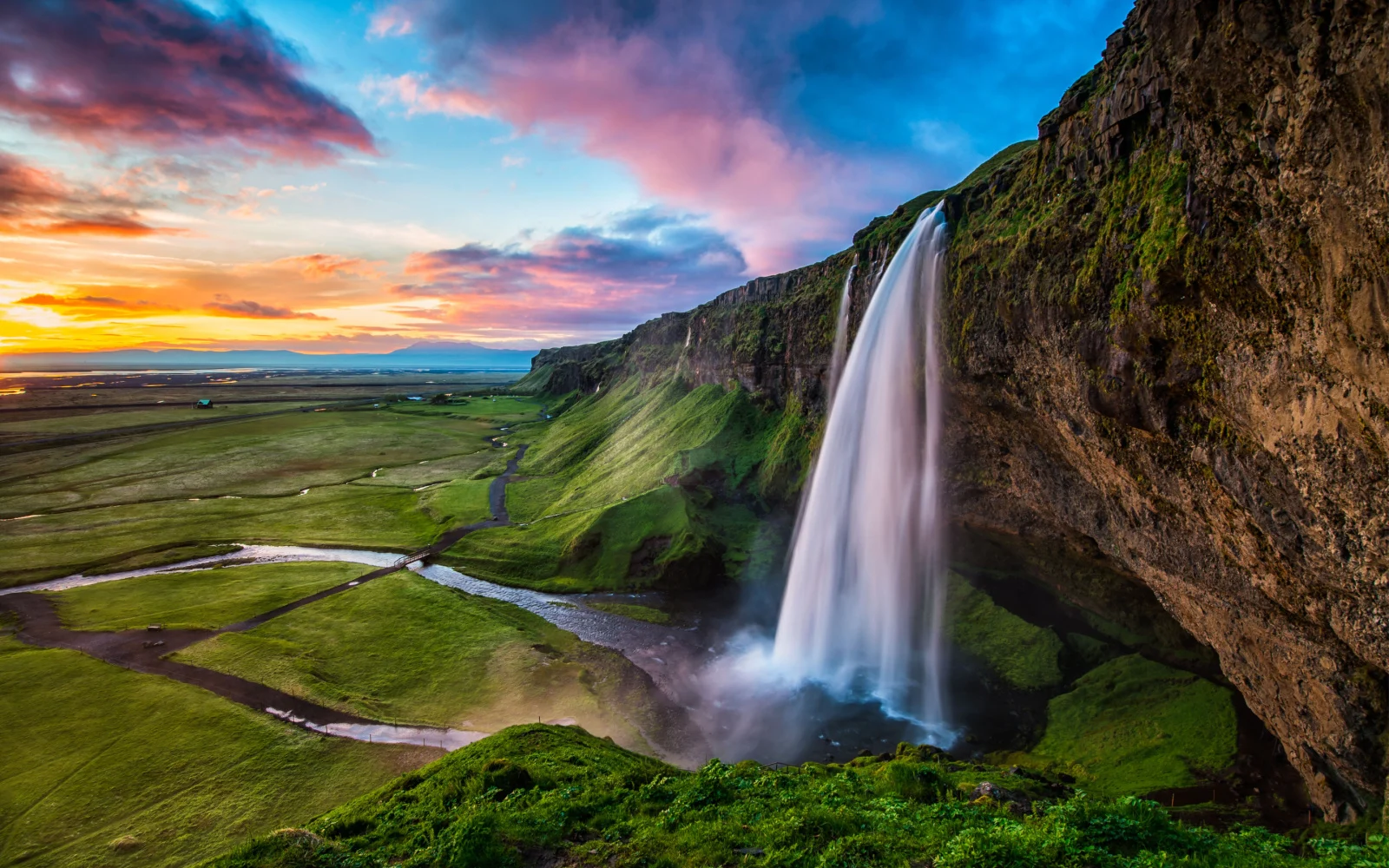The Land of Ice and Fire is home to some of the world’s most dramatic landscapes, cozy villages and bustling cities, and amazing national parks. The best places to visit in Iceland will bring you to the country’s tourism highlights for the trip of a lifetime.
We’ll show you the 15 best places to go and things to do while you’re in Iceland to give you a taste of what this rugged and beautiful country is hiding among its glaciers, hot springs, volcanic mountains, and Viking history below.
15 of the Best Places to Visit in Iceland
Reasons to visit Iceland are vast: Outdoor adventure in its national parks laden with glaciers, volcanoes, fjords, and waterfalls, seeing the Northern Lights dancing in the sky, tracing Viking history in ancient dwellings and landmarks, and touring and exploring its cities (like Reykjavik) and quaint fishing villages.
From sightseeing, dining, and shopping in the bustling capital surrounded by beautiful views to exploring the country’s rocky fjords and steamy hot springs on a classic Golden Circle tour, a trip to Iceland is one you won’t forget.
Check out the 15 best places to visit in Iceland below and get to know the beautiful contrasts in the Land of Ice and Fire for its most prominent features and otherworldly landscapes!
1. Reykjavik
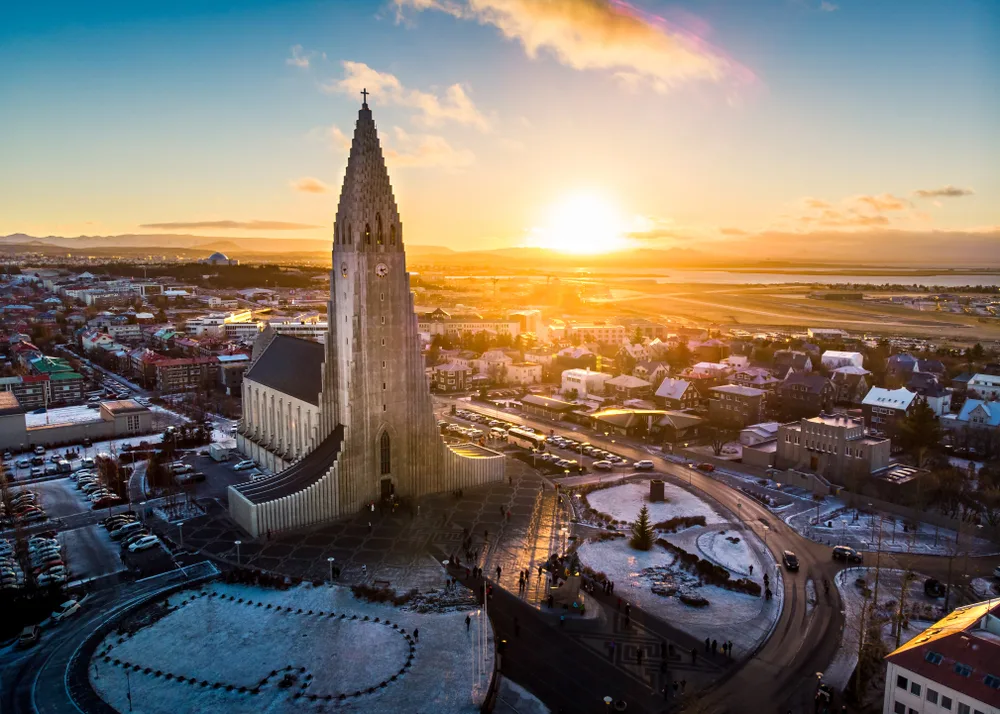
Creative Family/Shutterstock
The capital, Reykjavik, is the perfect starting point for any Iceland adventure and getting to know its culture, history, and people. There are great museums, vibrant nightlife, and amazing restaurants, spas, and views to enjoy while you’re in the city.
We recommend starting your trip with a City Walk tour around the heart of Reykjavik (you’ll pay what you think it’s worth at the end) to see some of the highlights and get familiar with the layout of the city. Your guide will tell jokes, detail the city’s past, and end the tour with a piece of licorice — you’ll either love it or hate it!
Once you’ve got your bearings, you can set out in earnest to explore the museums and galleries. The Saga Museum brings Iceland’s Viking history to life with moments in history and audio guides in multiple languages. Perlan, a nature and wildlife museum, features an awesome glass dome observation deck and manmade ice cave to explore.
Visiting Perlan earns you a free bus ride over to the Harpa Concert Hall, where you might luck out and catch world-famous acts performing (even comedians). It’s just 8 minutes to the Hallgrimskirkja church, built with concrete, and nearby art galleries.
Go shopping, grab food, and catch a buzz on Laugavegur Main Street. There’s a mind-boggling amount of bars, pubs, and craft breweries are other highlights to hit while you’re in the capital, and the nightlife is legendary here!
The city also boasts whale and puffin tours, famous hot dog stands (load it up with 2 types of mustard, bacon, fried onions, and raw onions), and close proximity to the steamy geothermal spas at Blue Lagoon (about an hour southwest).
2. The Blue Lagoon
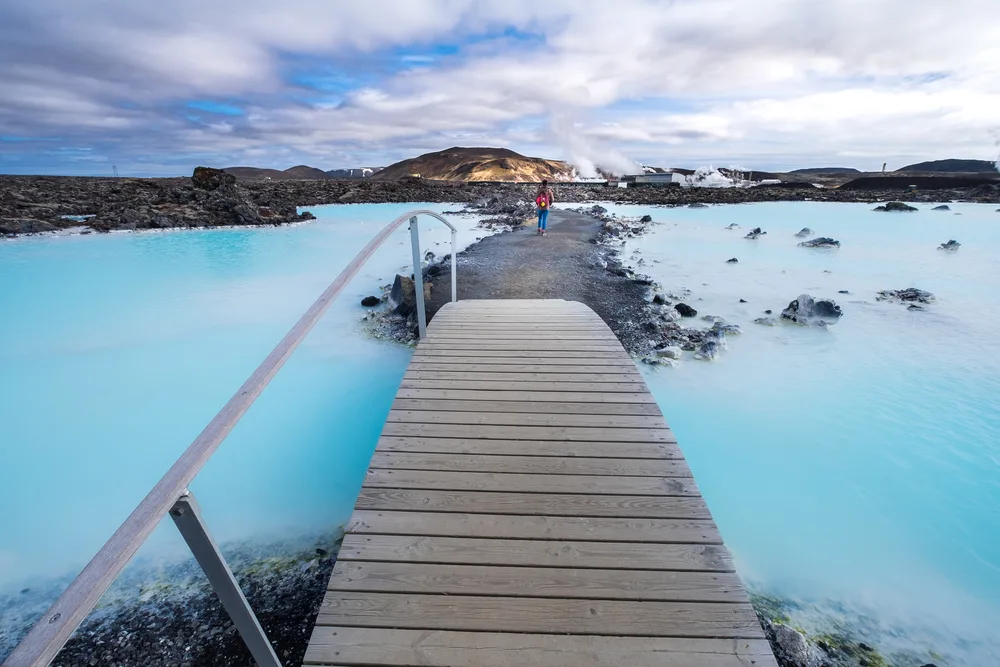
Puripat Lertpunyaroj/Shutterstock
It’s one of Iceland’s most famous attractions for good reason — the Blue Lagoon is an outdoor pocket of warmth and total rest and relaxation in a lava field on Iceland’s southwestern coast. Steam rises from the stunningly blue, naturally heated waters and beckons you to come in for a dip!
About an hour from Reykjavik, the Blue Lagoon is easy to reach and such a rewarding place to visit on your trip to Iceland. Wooden boardwalks lead out to the steamy water with incredible views of the rocky, lava landscape. There’s a trail you can walk around the lagoon to explore the area and stretch your legs after a heavenly soak.
The waters of the Blue Lagoon are rich in natural minerals. You’ll find the Blue Lagoon Retreat Spa the perfect place to complete your journey for rest and relaxation with facials, in-water massages, and serene floating mats that whisk you into a reverie of peace.
There’s an artificial beach where you can lounge on sunny days or venture out in a kayak. You won’t go hungry or thirsty with the In-Water Bar, Moss Restaurant, Lava Restaurant, and Spa Restaurant offering tasty traditional Icelandic cuisine.
Read Next: The Best Time to Visit the Blue Lagoon in 2025
3. Golden Circle
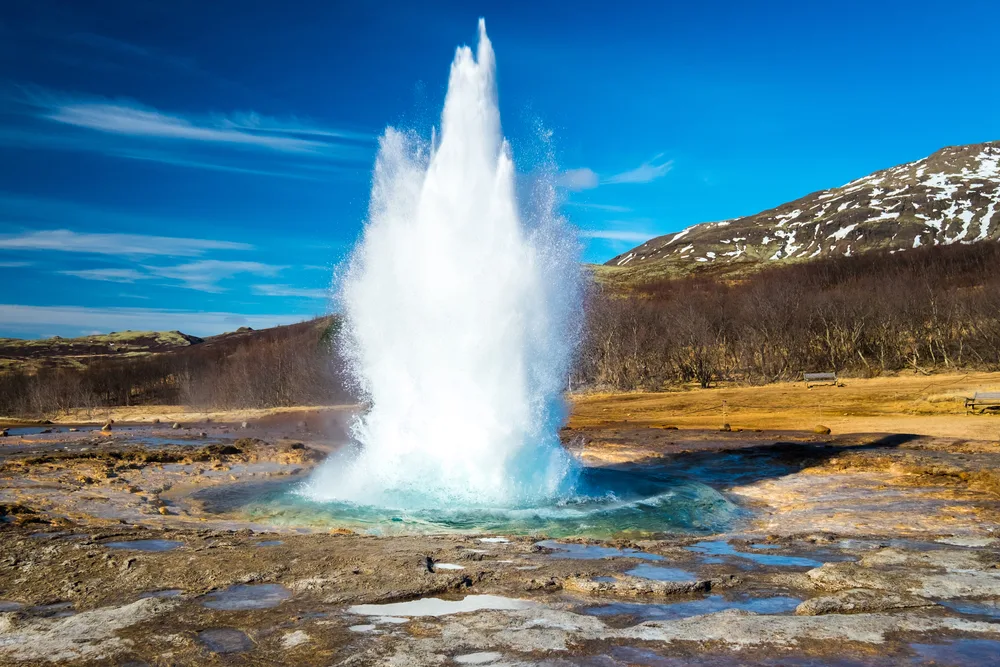
Puripat Lertpunyaroj/Shutterstock
Touring the Golden Circle is a classic way to experience some of Iceland’s best places to visit on a day trip with several impressive stops. You’ll get to see Iceland’s best waterfall, a thrilling national park, and an active geyser on this awesome adventure through the country’s coolest natural features.
The big 3 stops for any Golden Circle tour are Geysir Geothermal Park, Gullfoss Waterfall, and Thingvellir National Park (featured in Game of Thrones).
Geysir Geothermal Park features an array of hot springs, gushing geysers, and mud pools that bubble and pop as they’re heated deep underground. You’ll get to see the most famous active geyser in the country, Strokkur, erupting every 5-10 minutes while you’re here.
In the canyon of Hvita River, you’ll hear the thundering Gullfoss Waterfall before you see it in its cascading glory. The water rushes down into a deep canyon and provides some amazing photo opportunities on your Golden Circle tour.
The last stop is Thingvellir National Park, which was featured in parts of the Game of Thrones TV series and has been honored as a UNESCO World Heritage Site. The park is home to Iceland’s biggest natural lake, Þingvallavatn, and dramatic scenery with cliff faces, valleys, natural springs, and the rift between the North American and Eurasian tectonic plates.
Add other stops and activities to your Golden Circle tour, like horseback riding, snowmobiling, spa visits, and boat rides to really make your visit special. There are tons of Golden Circle tour operators offering unique experiences to these 3 stunning destinations.
4. Snæfellsnes Peninsula
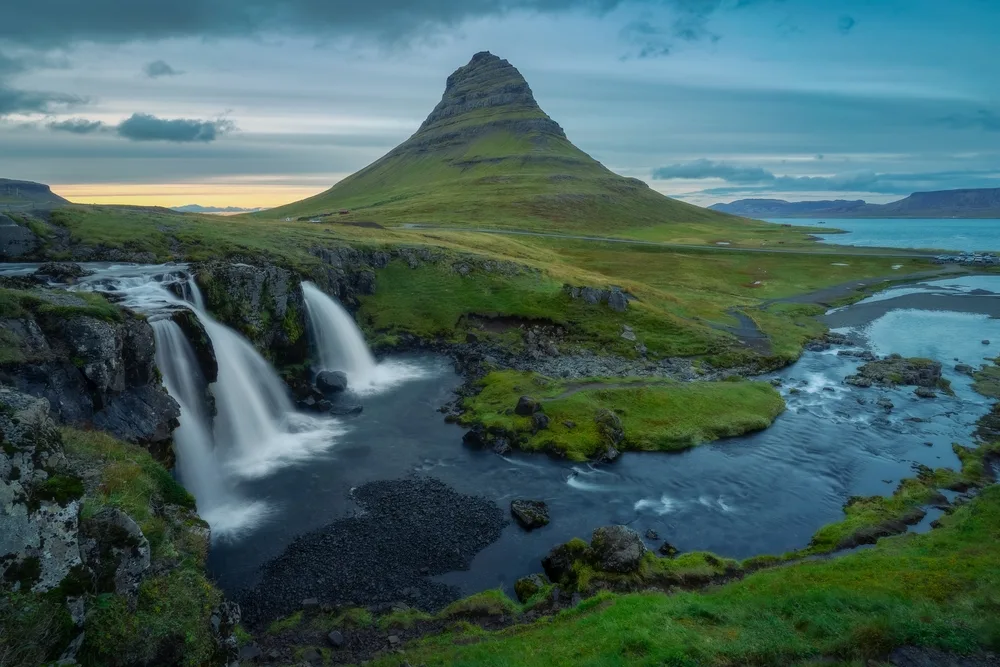
Ivan Kurmyshov/Shutterstock
Iceland’s Snæfellsnes Peninsula is one of the most scenic, diverse regions of the country to explore along its western coast. You can find rocky fjords, basalt cliffs, yawning canyons, rushing waterfalls, and stunning mountain views on this long peninsula that draws tourists to its rugged and wild landscapes.
The peninsula is home to the Snæfellsjökull National Park where you’ll find the 4,744 foot-tall Snæfellsjökull volcano and some of the country’s most dramatic scenery, volcanic black sand beaches, hiking trails, and drives.
You’ll see the basalt columns rising above the ocean at the Gerduberg Cliffs, natural springs like Olkelda Mineral Spring, volcanic rocky beaches, like Djúpalónssandur Beach, and amazing gorges and canyons that rip into the landscape and flow with waterfalls at Rauðfeldsgjá Gorge.
There are cascading waterfalls galore, like Bjarnarfoss, Svöðufoss, Kirkjufellsfoss (great mountain views here), Grundarfoss, and triple cascades at Selvallafoss (“Sheep’s Waterfall”) along with the Vatnshellir Lava Cave.
Consider camping at the tiny fishing village at the base of Mt. Stapafell, Arnarstapi. Take the hike between Hellnar and Arnarstapigo and see the Lysulaugar hot springs, climb the staircase up to the top of the Saxhóll crater, and take a whale watching tour to see orcas.
5. Jökulsárlón Glacier Lagoon
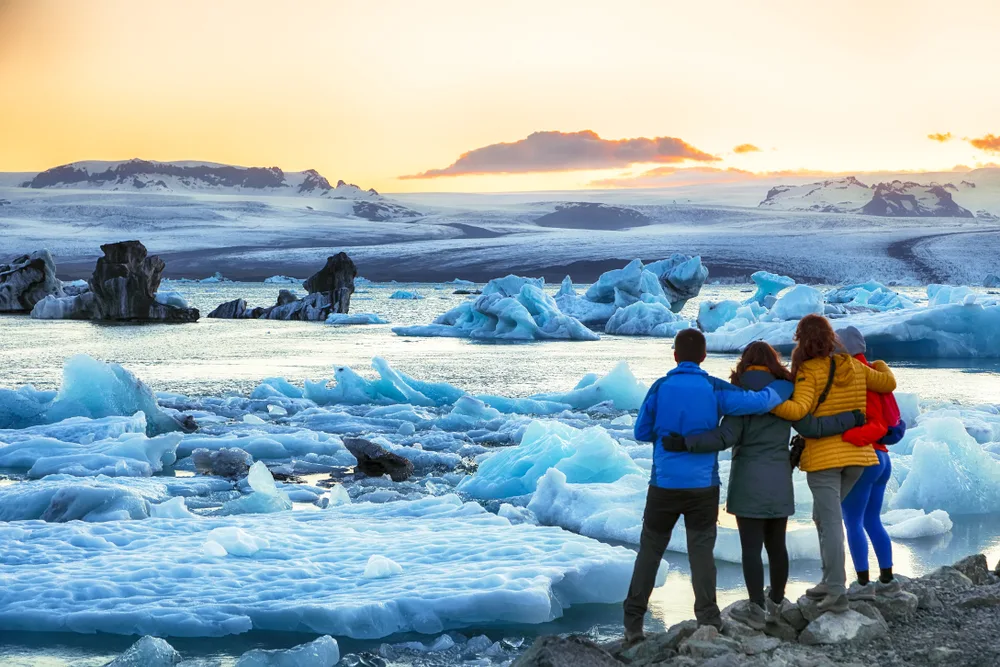
Vadym Lavra/Shutterstock
The Jökulsárlón glacial lagoon sits on the edge of the Vatnajökull National Park just off Iceland’s southeastern coast. It’s a place of reflection with the massive glaciers and icebergs rolling in the dark and frigid lagoon, making their way up to Fellsfjara (Diamond Beach).
You can feel the imposing presence of ice that’s older than anything you’ve seen before appearing before you in its absolute majesty. Parts of the Vatnajökull Glacier and its “offspring,” the smaller Breiðamerkurjökull Glacier, bob in its waters before being slowly pushed out to the Atlantic.
Visitors echo the same sentiments over and over — this is a place you have to see to truly appreciate. Pictures don’t do it justice and the magnitude of the ice, mountainous surroundings, and isolation of the place will catch you off-guard. The bright blue color of these massive chunks of ice creates an incredible contrast against the black sand beach nearby.
The black sand beach is at the mouth of the lagoon where it empties into the ocean at Fellsfjara, which becomes littered with tiny shards of ice that sparkle in the sun like diamonds (hence the nickname, Diamond Beach).
You can take land, amphibian, or Zodiac boat tours around the lagoon for incredible views of the glacier lagoon. You’ll see seals playing and diving for fish in the waters around the massive chunks of ice, getting the feeling that you’re peering into a truly natural and balanced world.
6. Þingvellir National Park
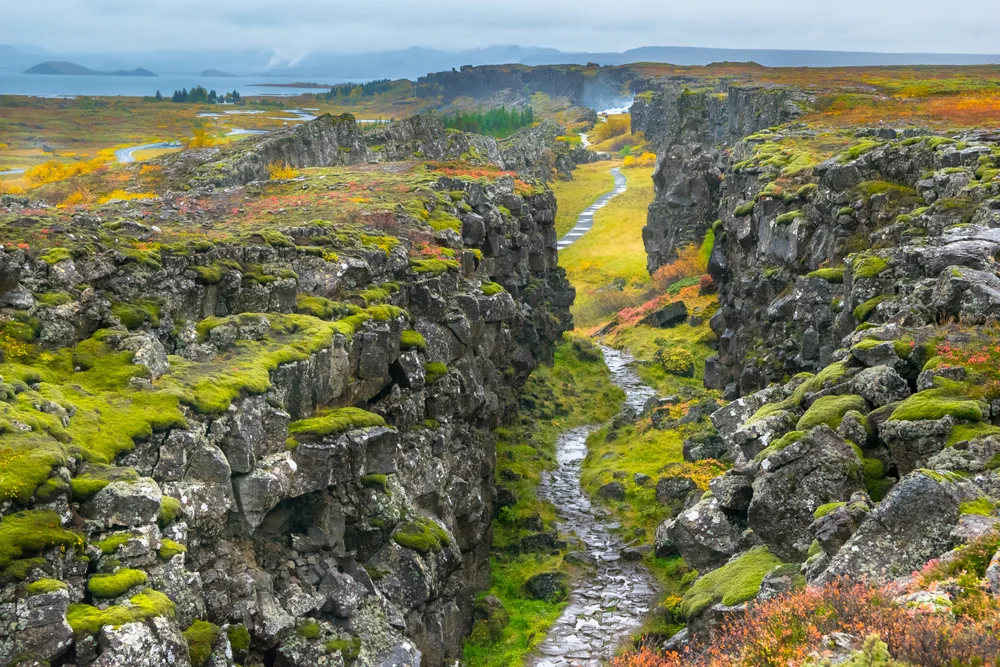
Nido Huebl/Shutterstock
If you’re not up for a full Golden Circle tour (or just don’t have enough time), the nook-and-cranny landscape and geologic diversity of the glacier-carved Þingvellir National Park (Thingvellir National Park) make it well worth a visit all on its own.
Iceland’s parliament, or some version of it, started meeting in this very part of the land in 930 AD (this, along with it being Iceland’s oldest national park, is why it’s a UNESCO World Heritage Site). Imagine scores of Vikings, huddled around roaring fires among the cliffs and rock walls, discussing the plans for their people and battles all those centuries ago.
Featured in cold-weather scenes in the HBO TV series, Game of Thrones, this stunning national park is home to majestic mountains, rocky landscapes covered in moss, seasonal wildflowers or snow, and amazing waterfalls.
The mighty river Öxará flows through the park and you can hike down the Almannagjá gorge, where the river flows downward and transforms into the Oxararfoss Waterfall.
There are 17 named mountains inside the park, including Syðstasúla (3,586 ft), Miðsúla (3,563 ft), and Háasúla (3,356 ft), each one offering chances to climb up for panoramic views over some of Iceland’s most prominent Viking history spots and amazing scenery that makes a trip here unforgettable.
It’s also an excellent place for outdoor activities like hiking, camping, fishing, and more. Explore the ancient ruins within its bounds like Althingi (the old Parliament), Law Rock (where laws were declared), and other archaeological sites from centuries ago.
7. Húsavík Whale Watching Tour
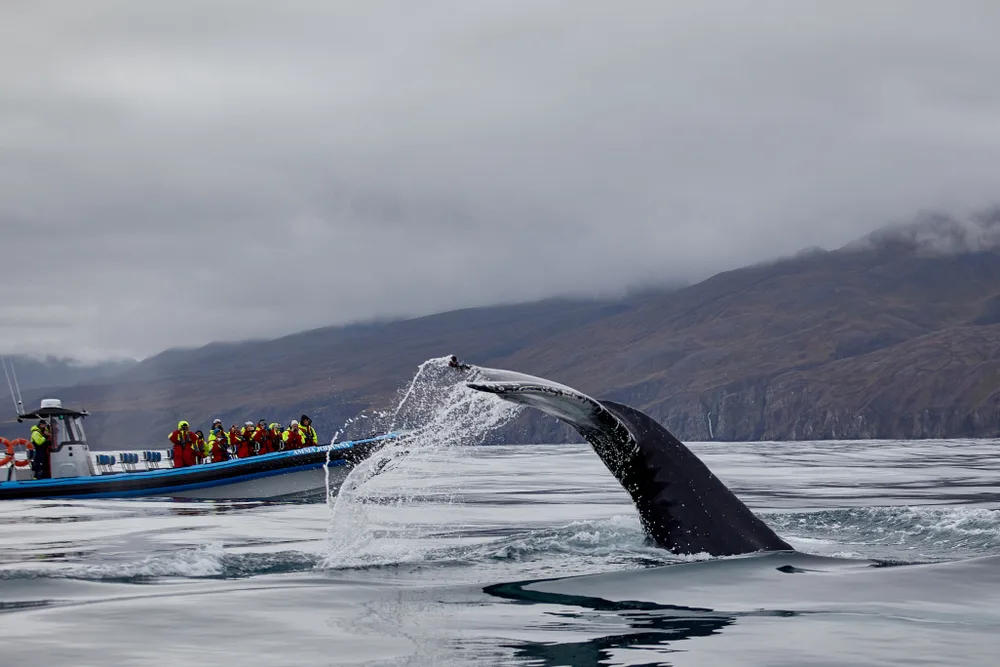
J_K/Shutterstock
Iceland is famous for its top-tier whale watching, and some of the best glimpses of humpback, blue, minke, fin, and killer orca whales can be had from the whale-watching capital of Iceland: Húsavík (the oldest settlement in Iceland) and its Skjálfandi Bay on the northern coast of Iceland.
This is a popular place to take whale-watching tours in the bay and you’re nearly guaranteed to see these massive, playful creatures breaching the water right beside your boat. The Skjálfandi Bay off Húsavík’s coast is an abundant feeding ground for whales, offering plenty of plankton and krill for them to eat and drawing them to the bay in droves.
And it’s not just whales that you’ll be able to spot when you visit Húsavík. Dolphins, porpoises, and migrating and regional birds like adorable puffins and Arctic terns are all possible sights when you take a whale-watching tour here.
There are several whale-watching tour operators based in Húsavík, each one offering their own twist on the marine journey with amenities like traditional Viking-style oak ships with huge viewing decks, knowledgable guides spinning history and bay tales, and onboard refreshments to warm you up during your chilly journey to the bay.
Swing by the Húsavík Whale Museum and Húsavíkurkirkja church when you get back to shore to add a little more Iceland culture and history to your trip. The church is the town’s most revered landmark that’s been standing since 1907.
You might even recognize the town from its feature in the 2020 Netflix movie, Eurovision Song Contest: The Story of Fire Saga, starring Rachel McAdams and Will Ferrell. You can visit the Eurovision Museum while you’re here and grab brews at Húsavík Öl when you finish up!
8. Vestmannaeyjar Islands
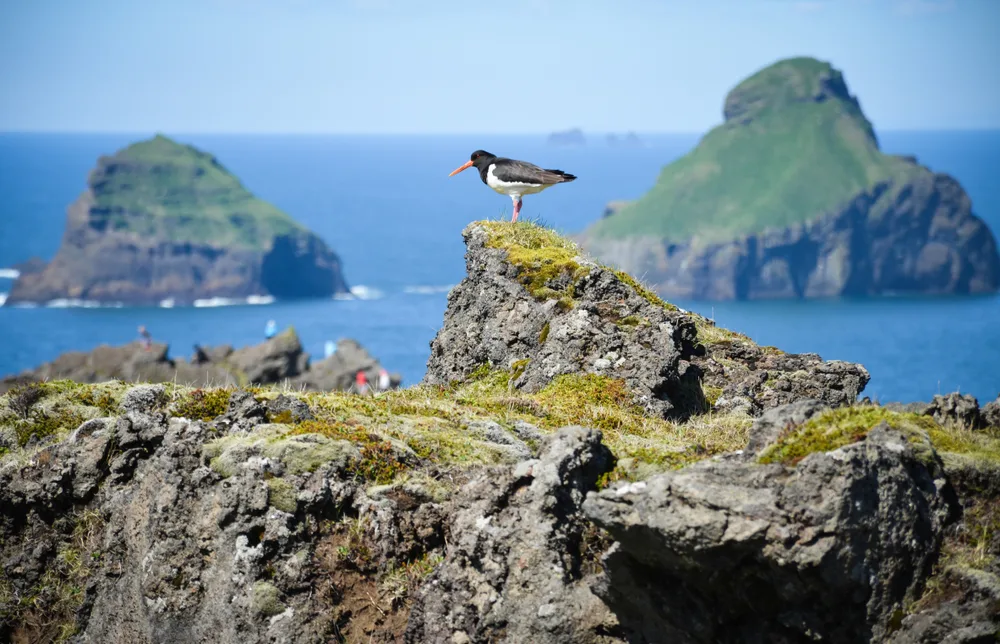
Iolya/Shutterstock
The Western Islands, or Vestmannaeyjar archipelago, is one of the best places to visit in Iceland. The archipelago includes 16 volcanic islands off Iceland’s southern coast, each one with a dizzying array of dramatic scenery, rocky beaches, 18+ craters to explore, and ominous volcanoes.
The main (and only inhabited) island, Heimaey, is the one you’ll head to on your unique Icelandic island adventure. It’s home to two volcanoes, Eldfell and Helgafell, along with the interesting exhibits at Eldheimar Museum covering the most recent 1973 eruption and its devastation to the town.
The other 15 islands are uninhabited and purely natural, save for a few hunting cabins scattered on 6 of them if you’re up for a truly secluded stay and exploration. Explore miles upon miles of hiking trails leading you to scenic vistas and ocean views.
Under the surface of the islands, a massive magma chamber boils, heating the volcanoes and resulting in occasional eruptions that add to the islands’ size and can devastate buildings and natural habitats. The youngest island, Surtsey, is a UNESCO World Heritage Site and is not open to visitors (with the exception of volcanic researchers) after its 1963-1967 eruption.
You’ll find great fishing, whale-watching, and birdwatching opportunities on the islands, too. Seabirds abound in the Western Islands, flocking to the skerries (rocky cliffs or reefs) and rocks protruding from the sea to rest after long flights. Whales, seals, and the largest puffin colony in the Atlantic can all be seen here!
Spranga is the local pastime and sport for adventurous Icelanders on the islands, involving thrilling cliff rappelling around Skiphellar near the harbor on Heimaey. When you arrive, don’t be surprised if locals lead you to the cliffs and encourage you to give it a try!
9. Myvatn Nature Baths
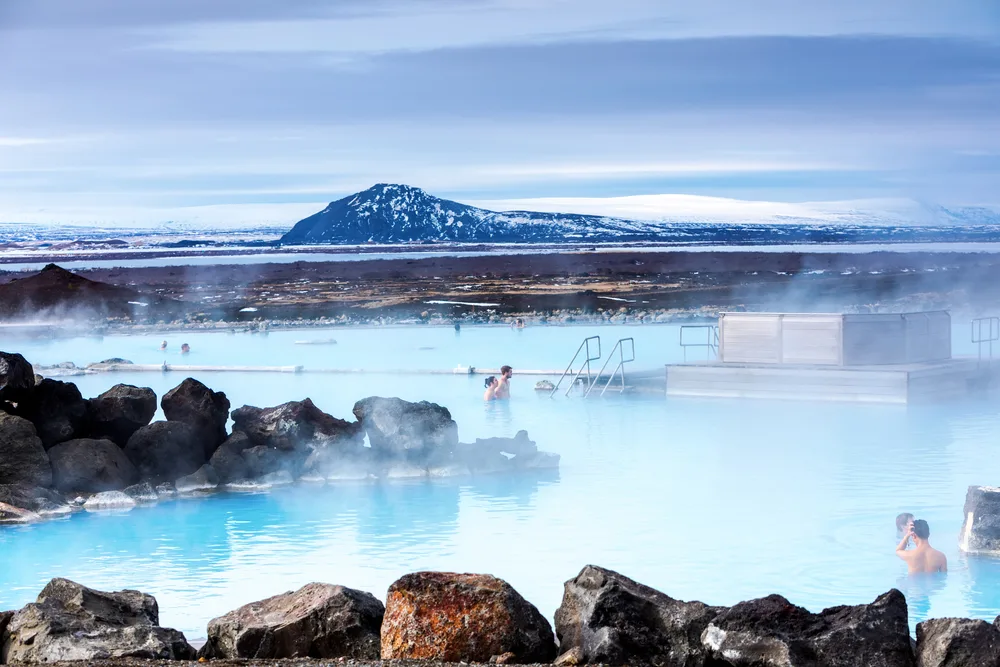
Ververidis Vasilis/Shutterstock
A warm soak sure sounds nice after venturing out into Iceland’s frigid parks, fjords, and glacial lagoons, so head over to Myvatn Nature Baths in northeastern Iceland to take a break from the chill in a warm, steamy pool lined by rocks with bar service as you bathe in the waters!
The Myvatn Nature Baths are made up of two geothermal pools, heated naturally by magma flowing underneath the surface. The waters here are delightfully warm enough to take a dip, even in the dead of winter, and it’s an incredible experience to lounge in the milky-cerulean blue waters with mountain views.
Water temperatures hang between 98°F and 104°F year-round, making these relaxing baths a must-visit destination anytime you visit Iceland. Steam vents and rugged mountain peaks surround you, creating an almost otherworldly landscape.
Grab a beer/wine bracelet at the entrance and staff members will bring you your drink of choice while you enjoy the pools and rejuvenate in the warmth of the baths. Get a massage, shower off in the changing rooms, and grab lunch at the cafe where you can dine on the deck overlooking the baths.
10. Seljalandsfoss Waterfall
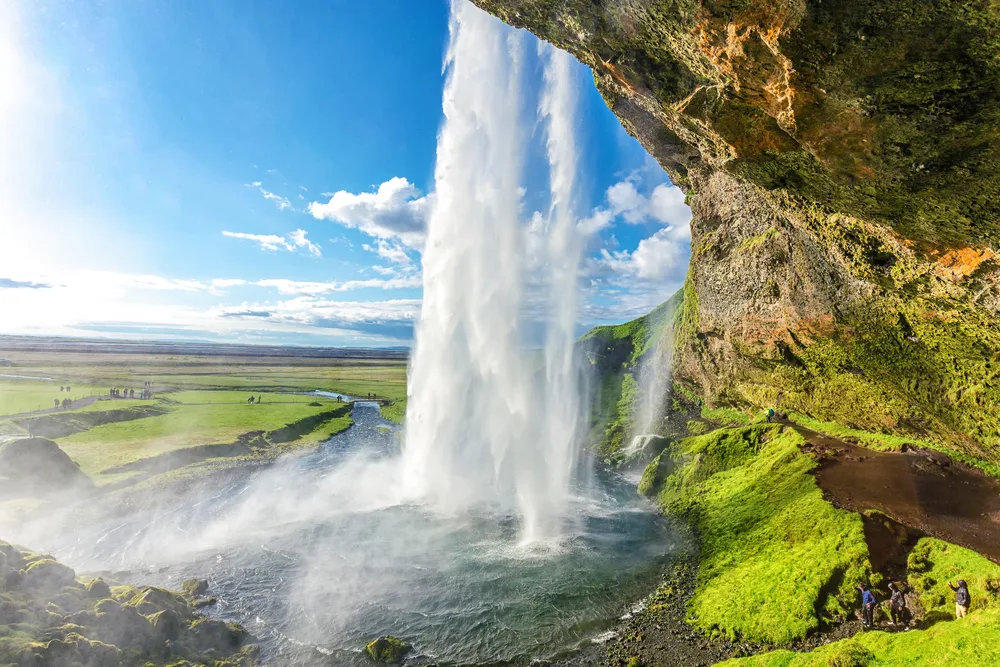
Cheng Yuan/Shutterstock
Seljalandsfoss Waterfall is one of the best places to visit in Iceland and a popular day trip from nearby Reykjavik, located about 2 hours south of the capital with amazing wilderness paths leading to this stunning cascade off the face of a jagged cliff.
Seljalandsfoss is impressive to witness as it thunders and roars over the cliff and down into a pool. It’s formed where the icy Seljalands River emerging from the Eyjafjallajökull volcanic glacier plunges nearly 200 feet over a cliff in a truly mesmerizing display of nature’s might.
Take the famous Ring Road to reach the waterfall, where you can view it from both sides of the road and stop off to get close to the falls and marvel at its size and strength.
If you’ve got some time to kill, wander through the small “hidden” cave behind the waterfall for a unique perspective of the flowing water.
11. Skaftafell National Park
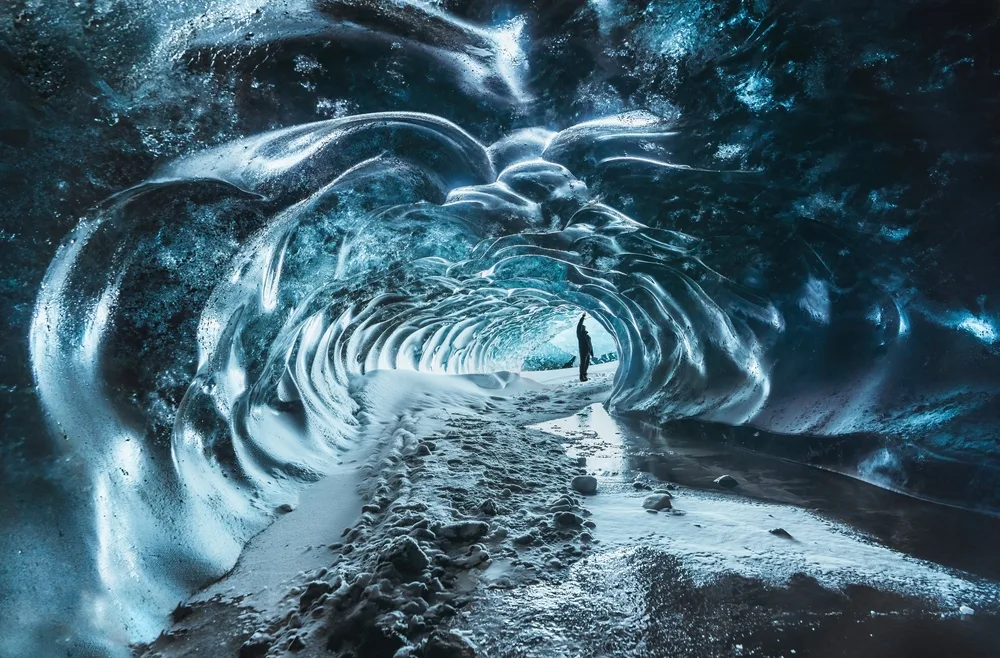
Mathias Berlin/Shutterstock
One of Iceland’s three national parks, Skaftafell National Park inside the larger Vatnajökull National Park is where you’ll find one of Europe’s biggest glaciers shining in the sunlight, an awesome array of wildlife, and spectacular landscapes showing the diversity and geologic uniqueness of Iceland.
People often come to Skaftafell to do the 3-hour glacier, or gletsjer, hike, starting at the glacier tongue on the southern coast, donning the proper equipment for scaling and hiking the ice cap, then “summiting” the massive Vatnajökull glacier, passing blue rifts and fissures, Icelandic wildness, and rocky coasts along the way.
Hiking trails within the park are another popular draw to the region. There are trails from easy loops to challenging treks all the way up Iceland’s highest mountain peak, Hvannadalshnjúkur.
Some of the best short trails will lead you to Svartifoss waterfall or out to the Skaftafellsjökull glacier for awesome, rewarding views and a sense of Iceland’s raw, natural beauty.
Skaftafell National Park is close to Jökulsárlón glacial lagoon and the famous black sand Diamond Beach (roughly an hour’s drive) if you’re up for a little more exploring beyond its bounds.
Keep an eye out for wildlife, like ptarmigans, golden eagles, and arctic foxes, while you’re in the park and bring binoculars to get a better view!
12. Dynjandi Waterfall
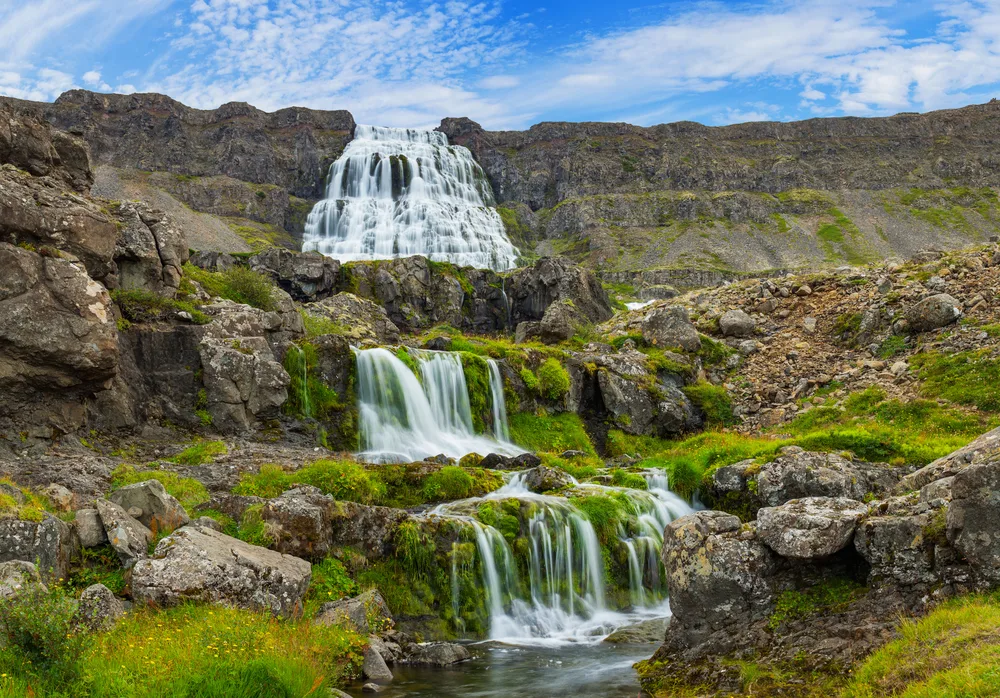
Max Topchii/Shutterstock
Iceland is just laden with amazing waterfalls, and on your trip, you can’t leave out the Dynjandi Waterfall. Located in Westfjords on the northwestern coast of Iceland by the Dynjandisvogur Bay and the renowned Arnarfjörður fjord, it’s the biggest cascade in the region.
You’ll find the waterfall tucked away at the end of the 100-foot long Arnarfjörður fjord in Dynjandisvogur Bay. It feels like you’re the first one to discover the massive fall as you walk up to it in this scenic, natural surrounding where the only sound is the roaring water.
The Dynjandi Waterfall (you might also hear it called Fjallfoss or Dynjandifoss) plunges almost 330 feet down into a small pool before continuing on into a series of smaller falls below it: Háifoss, Úðafoss, Göngufoss, Hundafoss, and Bæjarfoss.
You’ll be able to see all 6 falls rushing down when you arrive in the parking lot, but it’s well worth the hike up to Dynjandi at the top to keep your waterfall-chasing adventure going once you’ve arrived.
Fishing at the base of the falls, photography, and hiking are popular activities in the vicinity. Check out the viewing platforms if you’d like to get great views without a lot of hiking or chances of getting that chilly mist on your skin!
13. Glymur Waterfall
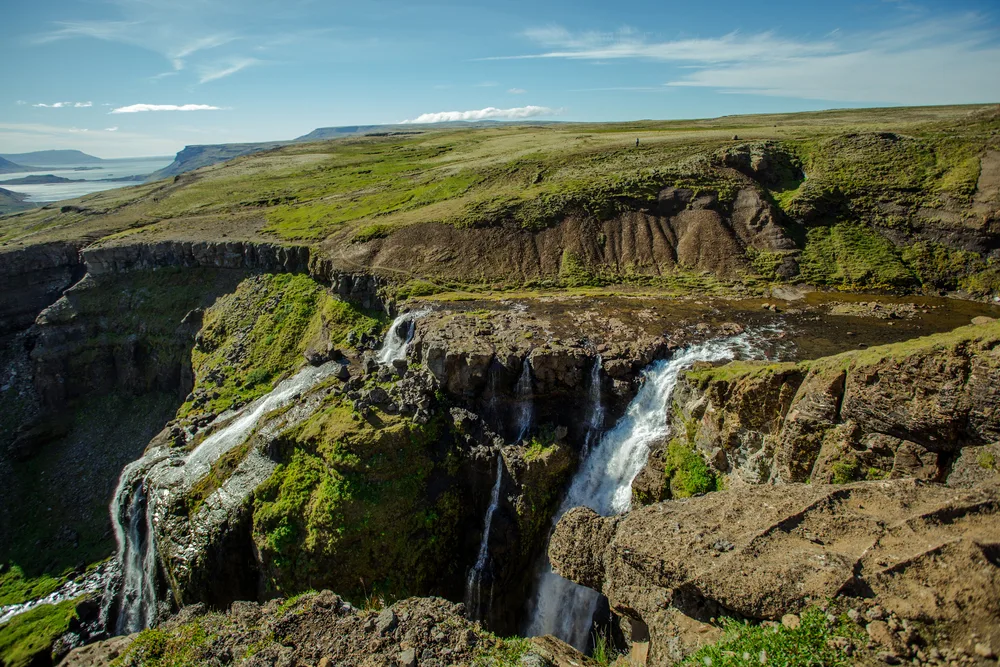
Ale_Koziura/Shutterstock
Head to Hvalfjarðarsveit in southwestern Iceland to see the marvelous Glymur Waterfall, the second-highest waterfall in the country at nearly 650 feet (only recently surpassed by the Morsárfoss Waterfall in Vatnajökull National Park).
The falls are carved into the scenic landscape and pass over mossy rocks on their plunge down to the canyon below. If you’re up for a hike, the Glymur Waterfall Trail is a nice loop that goes all the way around the falls, leading you to two river crossings to make your hike a little more adventurous.
The waterfall sits in the Hvalfjörður fjord, and the only way to get there is hiking. The trail begins at the parking lot and will take you past some beautiful views of the canyon, vast meadows, jagged cliff faces, and viewing platforms where you can stand close to or far from the falls for a different perspective.
It’s a moderate to challenging 4.3 mile trek that involves some tight squeezes and leaves you exposed to the elements. Pack accordingly and layer up if you’re visiting in the cooler months of the year!
14. Kerid Crater Lake
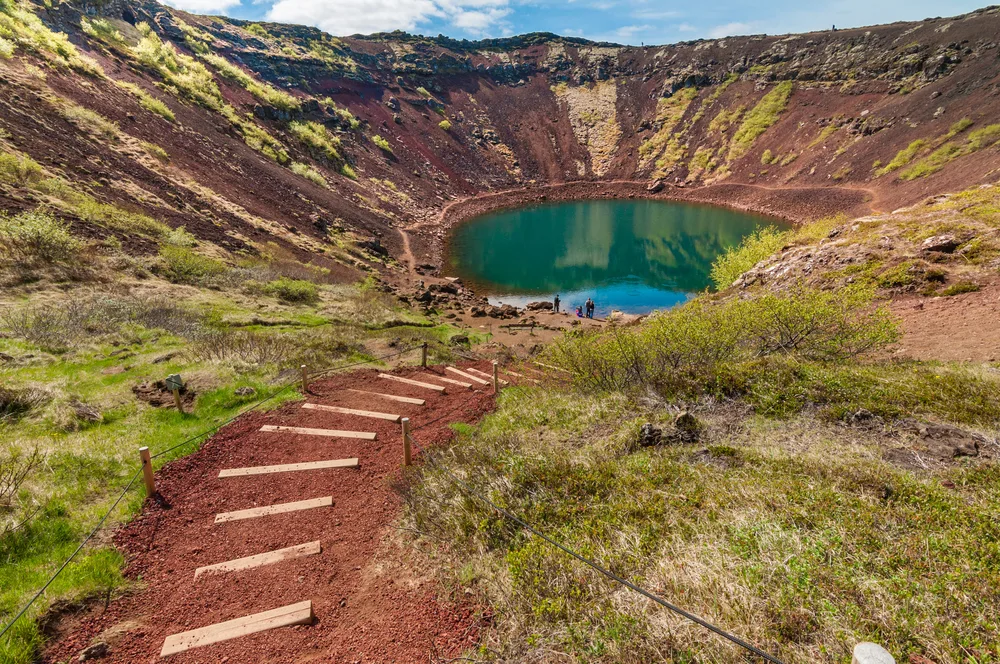
Mike-Hubert.com/Shutterstock
Iceland’s volcanic activity has carved the country a rich and varied landscape, dotted with volcanic craters like the Kerid crater — a massive depression that formed 3,000 years ago when a volcano erupted and created this stunning little alcove of wild wonder.
Located in southern Iceland in the Grimsnes region (you’ll pass it if you take a Golden Circle tour), this crater spans an impressive 180 feet deep and nearly 560 feet wide in the middle of Icelandic wilderness. The crater walls are two-toned volcanic rock with vegetation reaching down near the water inside.
The crater lake appears almost electric blue in color, a shocking contrast with the reddish, brown, black, and white-colored rock along its sloping walls. It’s truly a sight to behold, and if you’re okay with the near-freezing temperatures of the water, you can even go for a swim.
It’s part of a chain of volcanic craters called Tjarnarhólar craters, and while some of the others are privately owned, you can pay a small amount for access to see even more vivid crater colors in bright reds and jet black volcanic rock.
Hike the path around the rim of the crater for great views of its stunningly blue water and keep an eye out for the birds swooping down from the skies as you explore this natural area.
15. Reynisfjara Black Sand Beach
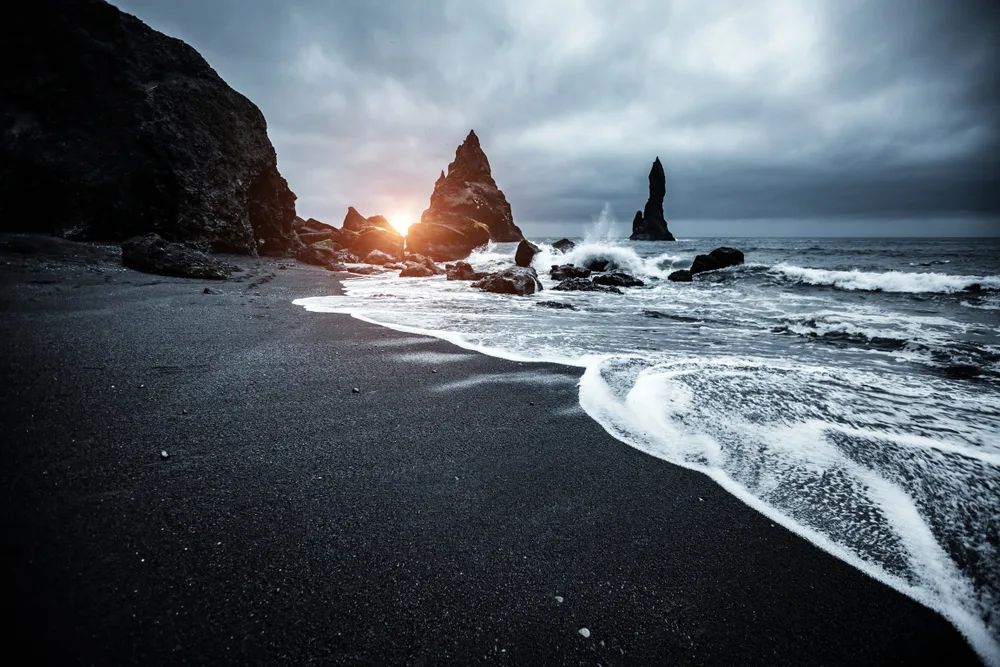
Creative Travel Projects/Shutterstock
Iceland’s southern coast is home to the Reynisfjara Black Sand Beach, close to a charming fishing village (Vik) near the capital of Reykjavik. Centuries of volcanic activity have left their trace in the form of black, coarse sand lining the shore here.
Basalt columns line the shore along with sea stacks rising like twisted, gnarled spires out of the frigid water to create an almost Martian landscape on this southern beach.
The basalt columns look man-made in their uniformity and shape, appearing like lopped-off tree trunks bundled together on the shore.
Head into the vaulted basalt column cave, Hálsaneshellir, while you’re at the beach — but watch your head in case of falling rock! The unique sea stacks in the surf have their own names: Landdrangur, Skessudrangur, Langsamur, and Steðji (the smallest). Together, they’re called the Reynisdrangar Sea Stacks.
The columns and sea stacks are tall, so you’ll feel dwarfed by the enormity and scale of these natural features while you’re strolling down the jet-black beach. Birds fly overhead, seals play in the water, and puffins congregate. Take the famous Ring Road from Reykjavik to reach Reynisfjara and explore its inky shores.
Things to Consider
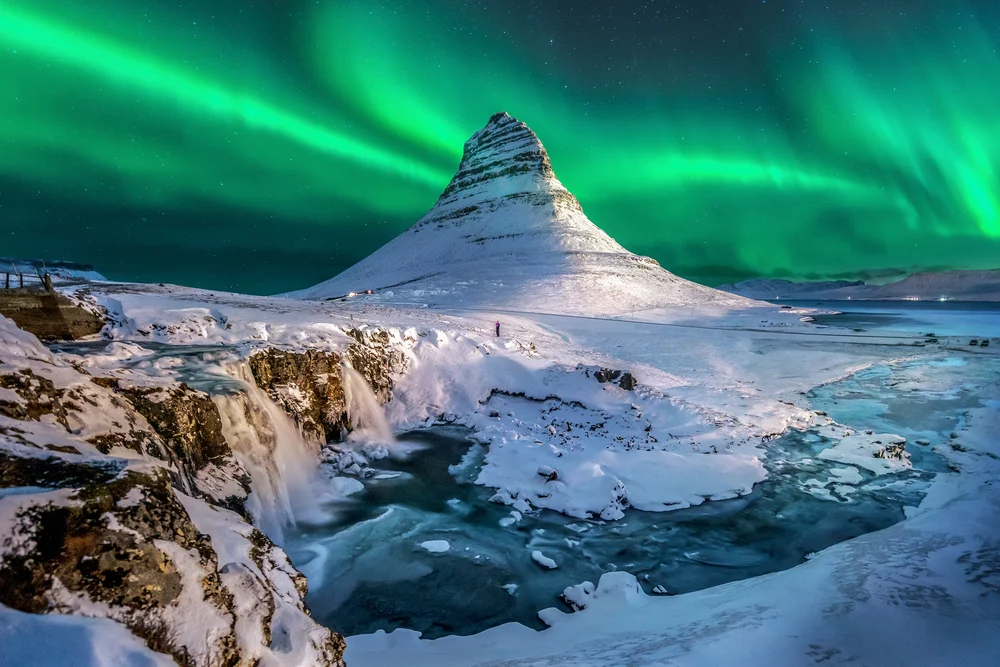
Thampitakkull Jakkree/Shutterstock
All the best places to visit in Iceland have something special to offer you, but you could miss out on some enjoyment if you’re not prepared with a few travel tips to make your trip easier. Here’s what you should keep in mind before going to Iceland’s coolest spots!
- Prepare for seasonal weather. Iceland has a cool and temperate maritime climate that’s characterized by cold winters and mild summers. You can expect temperatures between 50°F and 55°F during the summer months with long hours of sunshine and highs closer to 32°F in winter with short, darker days. Conditions can change quickly, so prepare by packing plenty of layers to bundle up if it gets chilly or remove if things heat up.
- Pick suitable accommodations. You’ll have a wide variety of places to stay in Iceland, but the larger cities, like Reykjavik, Kopavogur, Hafnarfjoerdur, and Akureyri will have the most options for accommodations compared to smaller areas where rental houses and cabins may be your only option. Consider hotels, unique glamping experiences under the Northern Lights, secluded cabins, or affordable hostels to suit your travel needs.
- Plan a realistic budget. Iceland can be an expensive country to visit with higher food, transportation, and accommodation costs, so it’s important to determine your budget and stick to it when you travel here. You might consider looking for a hotel or hostel with a mini fridge or kitchenette so you can prepare some meals at “home” instead of eating out, grabbing discounted passes for museums and tours from your hotel, and taking advantage of free outdoor activities.
- Get familiar with the culture and history. Icelandic culture is rich and varied, with many unique customs that are important to the local population. The extensive Viking, maritime, and natural history here are worth studying up on by visiting museums and taking guided tours around its cities and villages.
Frequently Asked Questions
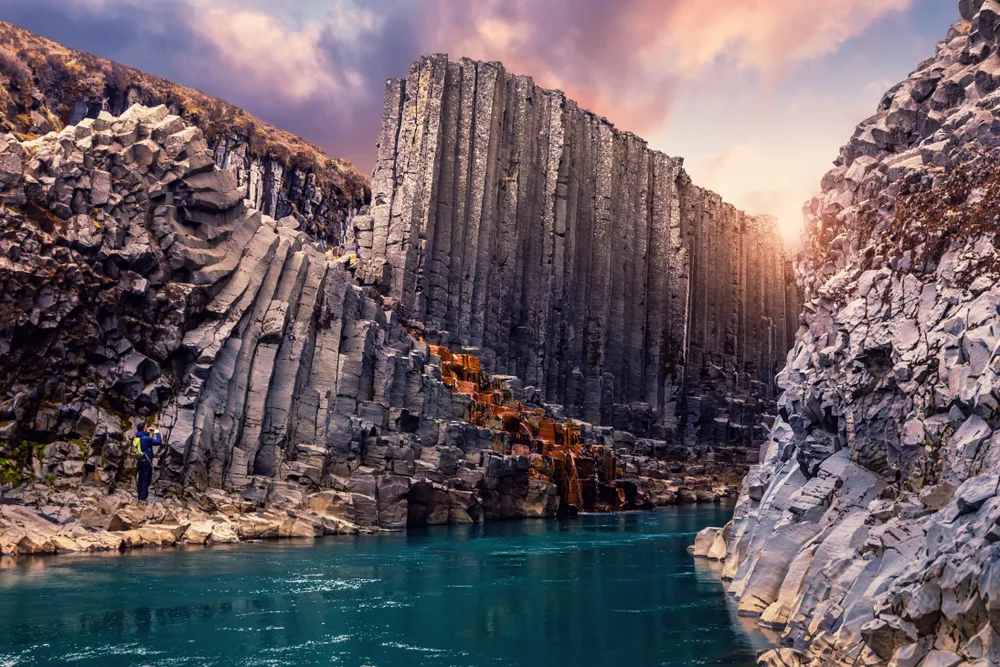
Yevhenii Chulovskyi/Shutterstock
What else should you know before planning your visit to the some of the best places in Iceland? Take a look at the FAQs below to learn more and get ready for your upcoming trip.
Where in Iceland is most beautiful?
Many agree that the most beautiful place in Iceland is Jökulsárlón, a glacial lagoon or lake near Vatnajökull National Park where you can see massive glaciers, icebergs, and wildlife like seals playing near a black sand beach that appears to be covered in "diamonds," or tiny shards of ice.
Other gorgeous spots to visit in Iceland include its other 2 national parks, Skaftafell and Thingvellir, which show you dramatic landscapes from volcanic craters and waterfalls to geysers and jagged, craggy cliffs.
Is 7 days enough to visit Iceland?
If you have 7 days to visit Iceland, it's plenty of time to explore some of the country's best areas and cities. Seven days is enough time to explore Reykjavik (3 days) for its museums, dining, nightlife, and shopping.
Then head out on a Golden Circle 2-day tour to Thingvellir National Park, the Geysir Geothermal Field, and Gullfoss waterfall to get a taste of the rest of Iceland's amazing scenery.
Finish up by visiting other waterfalls, venturing out to fjords and black sand beaches, or exploring another national park, going on a whale-watching tour, or taking an island expedition to the Westman Islands.
What is the best month to go to Iceland?
Mid-June to September is the best time to go to Iceland with chances to see the Northern Lights, experience mild, enjoyable weather, see wildlife in droves and landscapes at their greenest, and venture through cities like Reykjavik when everything's lively and fun.
How many days are enough for an Iceland trip?
Generally, 7 days (1 week) is enough for an Iceland trip, but it's even better if you can spend 10-14 days in the country. Iceland isn't huge, but some of the best places to visit in Iceland are scattered far apart and require some travel time in between.
Doing the Golden Circle tour, seeing Reykjavik and spending a little time there, and making time for whale-watching tours or waterfall exploration is key, making about 7-10 days the perfect timeframe.
Is Iceland very expensive?
We've found that the average 1-week trip to Iceland costs around $7,800 per person, making it an expensive place to visit overall. Most of the cost goes toward accommodations, food and drink, and entertainment (like museum tickets and tour costs).
You can make your trip to Iceland a little cheaper by visiting during the off-season in September-November or January-May, but conditions will be colder.
So, What Is the Best Place to Visit in Iceland?
The best places to visit in Iceland are its unique and vibrant cities, like Reykjavik, as well as its dramatic natural scenery and geological features like the Blue Lagoon, Glymur Waterfall, and national parks with boundless views of mountains, cliffs, glaciers, and fjords.
If you really want to plan a magical trip to the Land of Ice and Fire, you might consider moving from the Dynjandi Waterfall and its 5 lower falls at Westfjords to the Snæfellsnes Peninsula before doing the full Golden Circle tour to hit Geysir Geothermal Park, Gullfoss Waterfall, and Thingvellir National Park.
With everything from black sand beaches where glaciers and icebergs roll in the surf to captivating views of the dancing Northern Lights, Iceland is a place of enchantment and wonder with a natural ruggedness that appeals to everyone. By visiting its best destinations and features, you’ll enjoy the trip of a lifetime!



